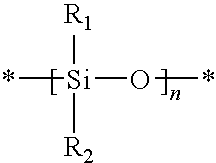Actinically-crosslinkable siloxane-containing copolymers
a technology of siloxane and copolymer, which is applied in the direction of sense disorder, group 4/14 element organic compounds, drug compositions, etc., can solve the problems of mold size fluctuations, molds may undergo non-uniform shrinkage, and molds inherently have unavoidable dimensional variations
- Summary
- Abstract
- Description
- Claims
- Application Information
AI Technical Summary
Benefits of technology
Problems solved by technology
Method used
Image
Examples
example 1
Oxygen Permeability Measurements
[0152]The oxygen permeability of a lens and oxygen transmissibility of a lens material is determined according to a technique similar to the one described in U.S. Pat. No. 5,760,100 and in an article by Winterton et al., (The Cornea: Transactions of the World Congress on the Cornea 111, H.D. Cavanagh Ed., Raven Press: New York 1988, pp 273-280), both of which are herein incorporated by reference in their entireties. Oxygen fluxes (J) are measured at 34° C. in a wet cell (i.e., gas streams are maintained at about 100% relative humidity) using a Dk1000 instrument (available from Applied Design and Development Co., Norcross, Ga.), or similar analytical instrument. An air stream, having a known percentage of oxygen (e.g., 21%), is passed across one side of the lens at a rate of about 10 to 20 cm3 / min., while a nitrogen stream is passed on the opposite side of the lens at a rate of about 10 to 20 cm3 / min. A sample is equilibrated in a test media (i.e., sal...
example 2
A. Difunctional PDMS Macroinitiator
[0164]This example illustrates how to prepare prepolymers of the invention.
[0165]
[0166]Preparation According to Scheme 1.
[0167]200 g (37 mmol) of α,ω-bis(hydroxyethoxypropyl)-terminated PDMS (KF-6003, MW≈5400 g / mol), 15.6 mL of diisopropylethylamine (90 mmol), and 1.2 L of hexanes are added in a 2 L round bottom flask. After the reaction mixture is cooled to 0° C. using an ice bath, 19.4 g (90 mmol) of 2-bromo-propionyl bromide in 60 mL of hexanes is added dropwise into the flask through an addition funnel. The reaction mixture is allowed to warm to room temperature and reacted for 12 hours with stirring. After filtration, the organic solution is washed with a saturated sodium biocarbonate solution (400 mL×2), followed by de-ionized water (400 mL×2). The organic phase is collected and dried over using anhydrous magnesium sulfate. After passing through a silica column and removing the solvent under vacuum, a slightly yellowish oil like product is co...
example 3
[0172]Actinically-crosslinkable prepolymers are prepared according to scheme 3 as follows.
[0173]
A. Synthesis of Br-PHEA-PDMS-PHEA-Br Block Copolymer
[0174]20 g (3.7 mmol) of difunctional PDMS macroinitiator (5400 g / mol) (prepared in Example 2, A), 42 mL (362 mmol) of 2-hydroxyethylacrylate (HEA), 0.04 g (0.19 mmol) of CuBr2, 0.52 mL (2 mmol) of tris(2-aminoethyl amine) (Me6TREN), and 160 ml of t-amyl alcohol are added to a 500 mL Schlenk flask. After four cycles of freeze-pump-thaw (20 minutes per cycle), 0.26 g (1.81 mmol) of CuBr is added to the flask under positive N2 flow. The reaction is carried out at 40° C. in the oil bath. The monomer conversion is monitored by gas chromatography. At a targeted monomer conversion, the reaction is stopped by opening the flask to air. The reaction mixture is diluted with THF and passed through a neutral aluminum oxide column. After addition of 5 mg of 4-methoxyphenol, the solvent is removed by rotavap. The concentrated solution is then precipit...
PUM
| Property | Measurement | Unit |
|---|---|---|
| molecular weights | aaaaa | aaaaa |
| water contact angle | aaaaa | aaaaa |
| water contact angle | aaaaa | aaaaa |
Abstract
Description
Claims
Application Information
 Login to View More
Login to View More - R&D
- Intellectual Property
- Life Sciences
- Materials
- Tech Scout
- Unparalleled Data Quality
- Higher Quality Content
- 60% Fewer Hallucinations
Browse by: Latest US Patents, China's latest patents, Technical Efficacy Thesaurus, Application Domain, Technology Topic, Popular Technical Reports.
© 2025 PatSnap. All rights reserved.Legal|Privacy policy|Modern Slavery Act Transparency Statement|Sitemap|About US| Contact US: help@patsnap.com



